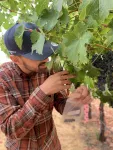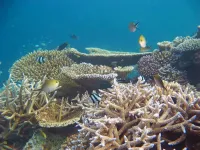(Press-News.org) One of the many challenges for grape growers posed by climate change is the accelerated rate at which grapes ripen in warmer climates, which can result in poor colour and aroma development.
In a new study published in the Journal of Agricultural and Food Chemistry, researchers from the University of Adelaide found it is possible to increase the flavour potential of Cabernet Sauvignon grapes by slowing down the ripening process with strategies including crop load manipulation and irrigation management.
Lead author, Pietro Previtali from the University of Adelaide's School of Agriculture, Food and Wine, said: "Advanced maturation due to warmer temperatures is a key issue for grape growers in most wine regions worldwide and especially in warm and dry areas such as Australia and California."
"It leads to faster sugar accumulation in grapes, which results in reaching the targeted sugar levels when the concentrations of colour and aroma compounds are below their maximum values.
"Growers therefore have to compromise between harvesting when sugar is ready but the desired flavours are missing, and prolonging grape maturation until an optimal composition of colour, mouthfeel and aroma compounds is achieved.
"The problem with prolonging maturation is grapes undergo shrivelling and yields are reduced with a negative consequence on profitability, and higher sugar levels that lead to high-alcohol wines."
Where earlier research has found techniques such as thinning vines and intense irrigation late in the growing season can change wine composition, the new study examined how these techniques specifically affect the development of aroma compounds in the grapes themselves.
The researchers grew Cabernet Sauvignon wine grapes at a commercial vineyard in the San Joaquin Valley in California. The vines were either thinned, or irrigated late in the growing season, or both, with grapes collected throughout the ripening period. These were compared with grapes grown in the same block where neither technique was applied.
The researchers found that delaying ripening slowed down sugar accumulation, which led to a decrease in green aroma compounds, unwanted in winemaking, and increased fruity aromas, colour and mouthfeel compounds, associated with red wine quality.
They also observed that the composition of grape quality traits is not dependent on a single strategy.
"Rather, groups of compounds were responsive to different factors, including crop load, irrigation, ripening rate and in some cases an interaction of these," Mr Previtali said.
Using the strategies available, the researchers sought to achieve the longest delay possible to study the relationship between sugar accumulation and flavour development. For example, a delay of three weeks was achieved through a 35 per cent reduction of crop load and late season irrigation of 50 per cent additional water.
"While representing a valuable experimental tool, this approach however may not be practical due to availability and high cost of irrigation, particularly as water becomes a scarcer resource," said Project lead and co-author, Associate Professor Christopher Ford, the University of Adelaide.
"Tailoring the management of these strategies seems to be the way to achieve the targeted levels of aroma compounds, colour and mouthfeel in wines."
The researchers say replication of these vineyard trials over future seasons is necessary to fully understand the implications of year-to-year variation, and develop a broader understanding of combining crop load and late season irrigation to delay sugar accumulation.
INFORMATION:
The study was conducted within the ARC Training Centre for Innovative Wine Production based at the University of Adelaide, with research partners from the Training Centre and E. & J. Gallo Winery in California.
Politicians use emotional resources in their speeches in parliament depending on the type of debate and use emotive rhetoric strategically and selectively, mainly to attract voters. This is one of the main conclusions of a study published in the journal American Political Science Review (APSR) involving Toni Rodon, a professor with the UPF Department of Political and Social Sciences and member of the Research Group on Institutions and Political Actors, together with Moritz Osnabrügge (Durham University, as first author) and Sara B. Hobolt (London School of Economics and Political Science).
"Our research provides evidence that incentives to attract voters differ systematically depending on the type of debate"
In recent years, much research has been done ...
Domestic burning of wood and dung fuels in Neolithic homes would have exceeded modern internationally-agreed standards for indoor air quality, exposing inhabitants to unsafe levels of particulates.
Working with environmental engineers, archaeologists at Newcastle University, UK, used modern air quality monitoring methods to assess the impact of domestic fuel burning inside buildings at Çatalhöyük, in Turkey, one of the world's earliest settlements.
A typical house at Çatalhöyük, a UNESCO World Heritage site, had a domed oven set against the south wall, located beneath an opening in the roof. In the 1990s, a replica of one of these houses ...
Reactive oxygen species (ROS) are highly reactive chemicals which contain oxygen radicals. Hypochlorous acid, peroxides, superoxide, singlet oxygen, alpha-oxygen and hydroxyl radicals are the major examples of ROS, which are familiar to persons from many walks of life as they are used in many domestic and industrial processes. ROS are naturally produced during a variety of biochemical reactions within the cell organelles such as the endoplasmic reticulum, mitochondria and peroxisomes. ROS are also formed as a byproduct of the normal metabolism of oxygen. The production of ROS can be induced by various factors such as heavy metals, tobacco, smoke, drugs, xenobiotics, pollutants and radiation. From various experimental studies, it is reported that ROS acts as either tumor suppressing or tumor ...
Malaria still kills millions. Researchers are excited by a new intervention: giving people a drug which kills mosquitoes that bite them. Incredibly, this is a reality, as the drug ivermectin, widely used for the control of parasite infections such as lymphatic filariasis and onchocerciasis, appears to do this. With some mosquitoes now resistant to the insecticides used in treated bed nets, this is a potentially important new control measure.
LSTM's Dr Rebecca Thomas and Dr Joseph Okebe, together with Dr de Souza from the Noguchi Memorial Institute for Medical Research (NMIMR(link is external)), University of Ghana, first examined the experimental evidence that giving the drug to people kills the mosquitoes that bite them.
All included studies showed large effects of ivermectin on ...
Predicting the potential effects of coral loss on fish communities globally is a fundamental task, especially considering that reef fishes provide protein to millions of people. A new study led by the University of Helsinki predicts how fish diversity will respond to declines in coral diversity and shows that future coral loss might cause a more than 40% reduction in reef fish diversity globally.
Corals increasingly bleach and often die when the water warms. What happens to fish if there are no alternative reefs to swim to? The few fish species that feed on corals will inevitably starve, but the rest might find alternative rocky habitat to persist. As yet, it has been hard to ...
By the beginning of April 2021, the number of people infected during the COVID-19 pandemic had risen to more than 130 million people of whom more than 2.8 million died. The SARS-CoV-2 virus responsible for COVID-19 is transmitted particularly by droplets or aerosols emitted when an infected person speaks, sneezes or coughs. This is how the viruses and other pathogens spread through the environment and transmit infectious diseases when they are inhaled by someone else.
The capacity of these particles to remain suspended in the air and to spread in the environment depends largely on the size and nature of the air flow generated by the expiration of air. As with other airborne infectious diseases such as tuberculosis, common flu ...
Significantly higher rates of child intensive care admissions for unintentional cannabis poisonings have been seen following legalization of the drug in Canada.
Researchers from The Hospital for Sick Children (SickKids), based in Toronto, found a four-fold increase in unintentional poisonings in children under the age of 12 and a three-fold increase in intensive care admissions for severe cannabis poisoning in the first two years following cannabis legalization.
However, the overall number of visits per month for cannabis intoxications to the SickKids Emergency Department (ED) remained consistent when comparing the pre- and post-legalization ...
Researchers at the National Institute of Standards and Technology (NIST) have upgraded their laser frequency-comb instrument to simultaneously measure three airborne greenhouse gases -- nitrous oxide, carbon dioxide and water vapor -- plus the major air pollutants ozone and carbon monoxide.
Combined with an earlier version of the system that measures methane, NIST's dual comb technology can now sense all four primary greenhouse gases, which could help in understanding and monitoring emissions of these heat-trapping gases implicated in climate change. The newest comb system can also help assess urban air quality.
These NIST instruments identify gas signatures by precisely measuring the amounts of light ...
A McGill-led study has shown that the size of the Maya population in the lowland city of Itzan (in present-day Guatemala) varied over time in response to climate change. The findings, published recently in Quaternary Science Reviews, show that both droughts and very wet periods led to important population declines.
These results are based on using a relatively new technique involving looking at stanols (organic molecules found in human and animal faecal matter) taken from the bottom of a nearby lake. Measurements of stanols were used to estimate changes in population size and to examine how they align with information about climate variability and changes in vegetation drawn from other biological and archaeological sources.
By using the technique, the researchers were able ...
Increasing our understanding of cellular processes requires information about the types of biomolecules involved, their locations, and their interactions. This requires the molecules to be labeled without affecting physiological processes (bioorthogonality). This works when the markers are very quickly and selectively coupled using small molecules and "click chemistry". In the journal Angewandte Chemie, a team of researchers has now introduced a novel type of click reaction that is also suitable for living cells and organisms.
As an example, labeling biomolecules allows for the localization and characterization of tumors ...



